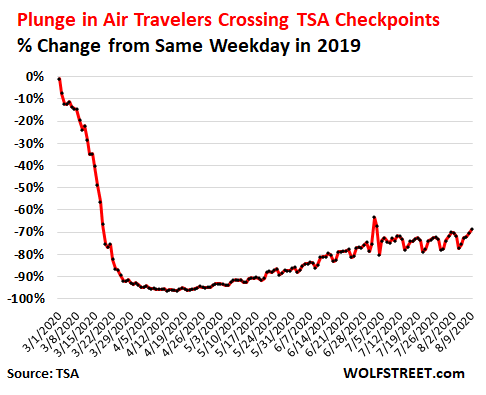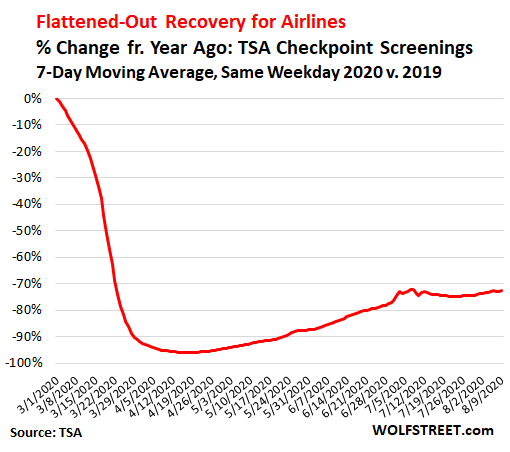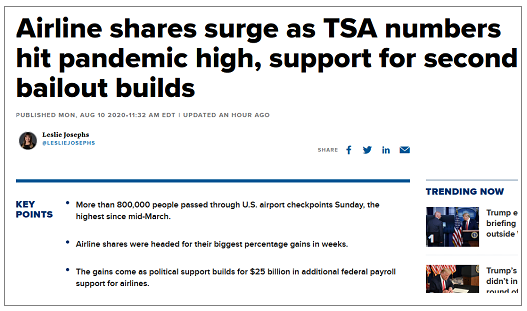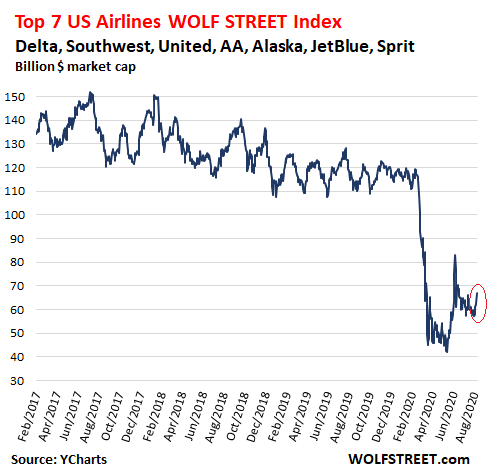Jerri-Lynn here. Like other people around the world, Americans are eschewing flying in response to the COVID-19 pandemic. Wolf has been following the carnage in the airlines sector, and I have featured some of his posts before (see Wolf Richter: The Chilling Things Delta Said about the Airline Business, the 90% Collapse in Q2 Revenues, and Why Some Demand Destruction May Be “Permanent”). Airline expert Hubert Horan has also weighed in on the situation (see Hubert Horan: Can Collateralizing Frequent Flyer Programs Help Save the US Airlines?; .Hubert Horan: Can Collateralizing Frequent Flyer Programs Help Save the US Airlines?; and Hubert Horan: The Airline Industry Collapse Part 3 – Recovery Expectations Were Always Dreadfully Wrong).
I don’t think demand will snap back, even if on the most panglossian scenario we see a viable vaccine soon – particularly for the key business-expense-account segment, as Wolf mentions below.
The airline sector is only past of the story. I also linked to an article in links today on the decimation in NYC restaurants, as well as another link on the decision of major chains to pull out of NYC. I think those stories are more a national harbinger than a regional story. Alas, the NYC I know and love – and I speak as a resident here – may be no more.
By Wolf Richter, editor of Wolf Street. Originally published at Wolf Street
The best day – meaning the least catastrophically worst day – in terms of air passengers entering to security zones at airports to board flights during the Pandemic wasn’t yesterday, as the financial media wanted to have us think, but July 2, when the count of TSA airport security screenings was down by only -63.4% from the same weekday in the same week last year, and on July 3, when the count was down by only -67.1% from a year earlier. That was over the extended Independence Day travel weekend.
Now it’s peak summer travel season. Yesterday’s TSA screenings – Sunday being a peak travel day – reached 831,789, the highest during the Pandemic. But it’s peak travel season and Sunday is one of the peak travel days, so last year on that Sunday, the TSA performed 2.65 million screenings, and this Sunday’s was down by -68.6% from Sunday a year ago. And the year-over-year decline has remained roughly in the same range since the beginning of July:

People are traveling to go on vacation. But they’re driving. All kinds of lodgings near or in national parks are booked. People want to get out and do stuff, and they have the stimulus money and the extra $600 a week in federal unemployment insurance. Early indications are that they’re driving more for vacation purposes than they did last year. That’s the big thing. But flying is still an iffy proposition for most people.
The seven-day moving average of the daily TSA screenings, which irons out the day-to-day ups and downs, has remained about the same since its best days since the beginning of July – “best” meaning least catastrophically down days. This indicates that the recovery of passenger volume has stalled since the beginning of July and is still terrible, terrible, terrible for the airlines:

Nevertheless, this situation caused the financial media to hyperventilate in an effort to pump up the shares. For example, CNBC reported breathlessly:

No capital-intensive business, such as an airline, can survive for long with roughly three-quarters of its business wiped out overnight, unless it undertakes a large-scale trimming-down, and unless it gets lots of financial help from all corners, including central banks and taxpayers. And that’s happening with airlines.
That’s the part in CNBC’s headline that nailed it: Another $25-billion bailout has been tucked into the next stimulus package.
It comes on top of the prior $25 billion in bailouts, mostly grants, that were designed to preserve airline jobs until September 30. Airlines have since told over 70,000 employees that they could lose their jobs after the deadline, and have incentivized them to leave voluntarily before the deadline, using a range of incentives, from buyout packages to early retirements.
Today, the WOLF STREET airline index of the seven largest US airlines – Alaska, American, Delta, JetBlue, Southwest, Spirit, and United – jumped 7.0%. Since word of the second $25 billion bailout package started circulating last Monday, the index has surged 15.7%. But it’s still down 44% from the end of the Good Times in mid-January 2020, and down a whole bunch more since January 2018. That 15.7% gain since last Monday is the little thing sticking up on the right of the chart (market cap data via YCharts):

And since last Monday, Boeing [BA] has jumped 13%. Boeing is going to be kept out of bankruptcy no matter what.
That’s what it really boils down to for the airlines: Hopes for another $25 billion, mostly in gifts from taxpayers.
Americans will gradually fly more, but it will take years before passenger traffic in the US recovers to levels before the Pandemic. It took years after 9/11 and after the Financial Crisis before air passenger traffic was back to the old normal.
But this time, the damage to the industry is a lot more profound. And the lucrative business-expense-account travel segment may have permanently changed, and might not fully recover even in the years to come. Airlines have acknowledged as much and are preparing for it, and they’re trying to trim down to a size that allows them to survive in this environment – but any series of $25-billion gifts sent their way is welcome.
And the stock market loves bailouts and hates the effects of capitalism where you could actually lose some or all of your investment when something goes awry.


FWIW, Amtrak is having a sale on Roomettes this month. Buy one seat, get a free companion ticket (half price for a couple). Meals included, BYOB. Choose carefully, and one can board and deboard at closed or isolated stations.
I was just about to go to San Fransisco from Vancouver via Amtrak to visit my best friend when the growing Covid threat made me cancel (around March 10th – I felt like I might be overreacting at the time!). The price of a room with it’s own bathroom and including meals was actually only a little more than economy class sir travel for the same trip much to my surprise.
If they do room service too it might be worth it. Last time I was on the Coast Starlight, eating was in the dining car and frequently strangers are seated at the same table to make space.
BYOB? Last time I had a roomette on the Coast Starlight they gave me a split of red wine on boarding, and there was a free wine tasting in the lounge car. The somellier put on a CD of Debussy’s La Mer as the Pacific came into view beyond the missile base.
This was a few years back, mind…
If I recall, alcohol was extra though a glass of wine may have been included with the dinner. Not a big drinker myself nor is my wife. She bought me a cocktail shaker for Christmas and we made Tuesday cocktail night where we try out some recipe we find interesting or revisit a favorite. We’re so wild that since we started this there have been weeks where we have imbibed up to three drinks in a single week! Verging on Fear And Loathing In Las Vegas territory!
The other train trips we had looked into involved visits to friends in Canada but when you start in Vancouver you have to start out with the most desirable and expensive part of the railway, the Rocky Mountain trip. Because of this our past trips to Canadian destinations have either been in the car or on a plane. I was really looking forward to that trip down the coast and still hope to do it at some point in the future.
Rail travel in Canada has become almost prohibitively expensive. I was on the last Toronto to Vancouver trip arriving in Van. on Feb 14, before the railway cancelled all subsequent trips across the country. Ironically, it was not because of Covid-19 initially, but as a result of a longshore/truck strike in Vancouver along with native blockades in Ontario jamming the rail lines, making it impossible for passenger service to maintain a schedule.
Haven’t checked in the last couple of weeks, but I think transcontinental passenger service is still suspended.
“And the stock market loves bailouts and hates the effects of capitalism where you could actually lose some or all of your investment when something goes awry.”
Huh. Right, well, maybe time to rethink how we deploy resources for productive activity?
Productive activity is what people who can’t afford to make political donations do.
Productive policy is what donors have paid for and it’s what they’re getting.
If you have to ask how much your policy costs, you can’t afford it.
Ms. Scofield, I just want to say that I love the term, “Panglossian.” (A fan of Voltaire here)
You made my day.
Well then, I am glad to hear that!
Was thinking the same thing! You roll out certain verbiage like showroom-lit classic cars.
Might be a good time to invest in high speed rail.
Jerry tried that and it has been a dud. So far.
One reason is because among myriad consultants Cal included the infamous SNC-Lavalin, the Montreal-based go-to disaster for credulous rail planners across North America and probably for Justin Trudeau. With “questionable business ethics”, they have pocketed tens of millions for light rail’s $9.2+ billion Honolulu single line (perhaps the first part may open end of Nov but the inaugural football game at the Aloha Stadium terminus is now problematic), but thankfully Duke University killed LNC’s effort on the Durham-Chapel Hill light rail boondoggle after *only* $130+ million was consumed in constant replanning & renderings that couldn’t quite hide that the train went nowhere particularly useful. Now as dark economic times descend, residents are at least not on the hook for *those* bonds. Good news, projections of traffic gridlock there are out the window, although Honolulu highways have been in that state for years before becoming “eerily quiet”.
High speed rail could actually be an energy-wasting investment in an energy-wasting technology system.
Here is an article from Low Tech Magazine called The age of speed: how to reduce global fuel consumption by 75%. It is applying to all forms of motorized transport the principle that as the car/bike/train/whatever goes through the air faster, the air resistance trying to slow it back down gets harder. At some speedpoint the air resistance gets so much harder so much faster that the object requires more fuel to go a set distance at the excessive speed than it would have required to go that same distance at below the speed of hitting-the-air-wall.
Here is the relevant paragraph demonstrating that principal for high speed trains as against merely fairly fast trains.
“Low speed trains
The blindness for the importance of speed leads to doubtful conclusions, like the environmentally friendly label of high speed trains. The French TGV that set the most recent speed record at 575 km/h for wheeled trains in 2007 has an engine output of 19,600 kilowatts. A contemporary “slow” train like the Siemens ES64 with a top speed of 240 km/h has a maximum power output of 6,400 kilowatts.
Travelling 1,000 kilometres, the “slow” train will consume 26,240 kilowatt-hours (over 4.1 hours) while the fast train will consume 33.320 kilowatt-hours (over 1.7 hours). A real slow train (like this one from 1956 with a top speed of 120 km/h) would consume only 20,000 kilowatt-hours over the same trajectory (and would do this in 8.3 hours, comparable to the travel time of a car).”
Here is the link to the whole article.
https://www.lowtechmagazine.com/2008/09/speed-energy.html
We should pursue optimum speed, not maximum speed, in trains as in everything else. The amount of money thrown away on high-prestige high-speed trains here and there could be better spent on a nationwide network of fairly fast trains going many places. I sometimes imagine turning the medians of all our Federal Interstate Highways into strictly passenger/zero freight railroads which could be called Federal Rail or some such thing. That could be a Green New Deal project.
California’s farmland-destroying nowhere-to-nowhere connecting high speed rail project will be the Three Gorges Dam of passenger rail.
Doing my part to keep the airlines solvent. Finally going home on 2nd of September after 5 1/2 months trapped by this pandemic. Flying Delta from Albuquerque to LA where I will fork over the royal sum of $225 for a rapid PCR 24 hour test at a private clinic called MyConciergeMD. 36 hours later I take an American flight to JFK and then two British flights to London and Moscow. The trip finishes with a short, 2+ hour flight to Crimea on Ural Airlines. I’ll be home by 9 pm local time on the 3rd. That works out to 5 flights and 6 airports – one twice. I’ll be wearing nitrile gloves (replaced every few hours), face masks (also frequently replaced) and a plastic face shield (I have pack of 5). I’ll purchase, at the gate, drinks and snacks for each major leg to minimize interactions with the cabin crew. I’ll also carry a baggy with clorox bleach wipes to clean my seat and tray table. Over reaction? Almost certainly but I will not get this virus during my trip. Not after isolating and social distancing every day for over 5 months.
The new problem with high speed rail is that the trains are sealed, in an atmospheric rather than Leninist sense. No openjng windows. I am not travelling with other people without windows. Better a three dag rumble through the Rockies with windows than a few hours in a tin can.
Unfortunately I don’t remember many opening windows on Amtrak either. The UK is just in the middle of replacing all it’s old and spacious and comfy high speed trains with opening windows in the vestibules (and no meaningful aircon) with new, high-density seating sealed trains. This may be a mistake.
Yesterday, I was at my Mother in Law’s house getting the house finalized for her return after a month recovering from COVID in the hospital and rehab (my father in law passed mercifully last Friday). They live in Sandston, VA, a mile as the crow flies from Richmond International Airport.
The entire three hours I was at the house, I never ONCE heard an airplane taking off. Jet noise is so common there as not to be a bother usually, but it was the silence of being alone in the house (almost never done that before in 20 years) and NOT hearing jet noise that was so odd.
I know RIC isn’t a hub or super busy normally, but this things are far from even normal levels.
for those of us who live under a frequent flight path (as the result of a change in runway use instituted abt 1/2 a dozen years after i bought my house so, no, i did not accept airplane noise when i bought the place), the return of air travel is a thing to dread.
I heard a BBC report a few weeks ago about how the reduction of Air Travel to Africa lead to a reduction of Animal Safari tourism in Africa . . . mainly East Africa. This reduction of tourism led to a reduction of money reaching the animal-tourism-based communities around and/or near the most touristed parks. The loss of tourism money meant a rise in survival poaching for meat and income.
If air travel to Africa is stopped the way the performative greens like Greta Thunberg want, the end of tourism will mean the end of money to the animal-adjacent communities. The animals will lose their economic reason to exist in a desperate starving East Africa where No Money = We All Die. The end of air travel and eco-tourism to Africa will lead to the systematic extermination-in -detail of every single edible
wild animal in East Africa on the way to turning all the parkland into farmland and grazing land.
That will be the endgame outcome of no more air travel. That won’t be what the anti-emissions warriors think they were asking for, but it will be what they get.
It could be that the Malthusian harbinger you illustrate is just an ecological inevitability anyway. This planet’ll have all of us for lunch, eventually.
the EIA publishes “jet fuel product supplied” in barrels weekly, which is roughly the equivalent of refinery deliveries to wholesalers or major users, and it has been below 50% of the same metric of a year ago for the duration, after initially falling to 70% lower year over year…